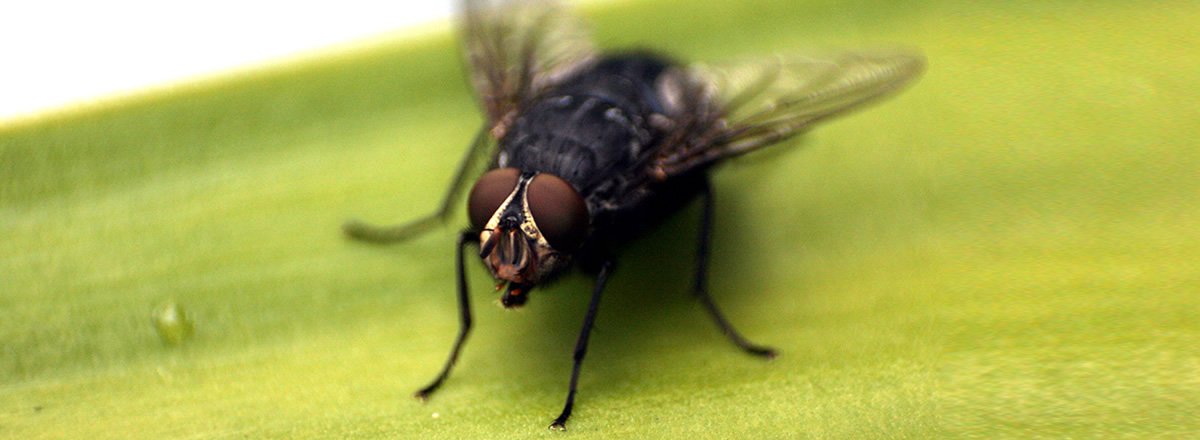House Flies Control in Badlapur and Thane
The most prolific pest among humans, at one point or another in your life, you will encounter a fly in your home, at work, or at school. However, did you know that nearly 90% of all flies encountered belong to the species musca domestica.
Identification
- Adults range from 4 to 7.5 mm in length; females are generally larger than males
- Light-grey in colour with four black, longitudinal stripes on the thorax
- Large, bulbous, multi-faceted eyes
- A pair of transparent wings
- Abdomen is yellow or partially yellow with a dark median line
They spread about 105 different kind of germs and bacteria. Controlled by chemical residual spraying. House flies are generally found in greatest numbers during the hotter summer months. House flies are less than 3⁄8 inch in length and have four dark stripes down the back of their thorax. House flies have sponging mouth parts and eat solid food by first liquefying it with their saliva. House flies can also regurgitate onto a solid food to assist with the liquefying process. House flies numbers can increase quickly due to their rapid immature developmental time and the large number of eggs produced by each female—several batches of about 100 to 150 eggs. Eggs are laid in warm, moist, organic materials such as manure, garbage, lawn clippings, decaying vegetables and fruits, or soils contaminated with any of these materials.
Most adult house flies travel within 1 mile of sites where eggs are laid and the greasy, cream-colored larvae (or maggots) develop. Garbage cans, large commercial trash containers, poorly drained areas around garbage receptacles, compost piles, human and pet excrement, open dumps and unsanitary conditions around food processing or rendering plants are likely larval sites. House flies maggots need a damp or semi-liquid medium in which to live since they can not chew dry food and are susceptible to desiccation. They feed on almost any man-made or naturally occurring moist or slimy vegetative or animal waste material such as household garbage. Keep these facts in mind when searching for fly breeding sites to clean up the area or apply insecticide.
During daylight hours house flies rest indoors on floors, walls and ceilings. They can be found outdoors on plants, the ground surface, fences and fence wires, garbage cans and other similar surfaces. At night they will rest indoors on ceilings, electrical wires and dangling light cords while they rest outdoors on fences, electric wires, edges of buildings and plants. In all situations they prefer corners and edges or thin objects such as wires and strings. Night resting places are usually 5 to 15 feet off the ground near daytime food sources. Knowing these typical resting sites is important when spraying surfaces with residual insecticides.
House Flies & Diseases
Global pests, house flies are common insects in Canada and the rest of the world. Closely associated with humans, the house fly poses numerous health threats because of its tendency of breeding in garbage and other filthy decaying matter. House flies have the ability to pick up, carry, and spread microorganisms that potentially cause disease. At least 65 different diseases are known to be linked to house flies, including anthrax, cholera, dysentery, leprosy, tuberculosis, and typhoid fever. Some of the most common pathogens transmitted by house flies include Salmonella and E. coli bacteria, which cause food poisoning.
House flies transmit diseases mechanically by unwittingly picking up pathogens from contaminated sites and physically carrying the pathogens to other locations. Decaying organic matter and animal feces are full of pathogens. When a house fly rests on and walks across such materials, it picks up the pathogens on its body hair and the sticky pads on its feet. When house flies enter indoor structures, they often come into contact with food preparation surfaces and human food, thereby spreading the disease-causing organisms to materials directly involved in the process of preparing and eating meals. House fly saliva and feces can also contaminate food items and cause humans to become ill.
House Fly Control
The First step in House fly control is exclusion and sanitation. After these measures, you can use insecticides that come in residual forms, aerosols, fogging materials, and baiting forms. Fly traps have long been a favorite. There are many forms of fly traps, from disposable fly traps to electronic fly light traps with replaceable light bulbs and glue boards.
Exclusion and Sanitation
- Sanitation is the first measure of defense, even though there are various traps and sprays that are used to kill flies, it is necessary to eliminate the source in order to eliminate them.
- Whenever possible, food and materials on which the flies can lay their eggs must be removed or destroyed, which will isolate the egg-laying adult. Killing adult flies will reduce infestation, but elimination of breeding areas is necessary for good House Fly control management.
- Garbage cans and dumpsters should have tight-fitting lids and be cleaned regularly.
- Drainage will often aid control, getting rid of extra moisture.
- Openings of buildings should be tightly screened with screen.
- 100% Reliable – We Turn Up On Time
- A Pest Company You Can Trust
- Courteous & Highly Trained Staff
- Proven Cockroach Treatments
- Prevention Techniques For Eradication Of Future Infestations
- Latest Technology & Equipment
- Full Inspection Of Properties
- Guaranteed Satisfaction Every Time

